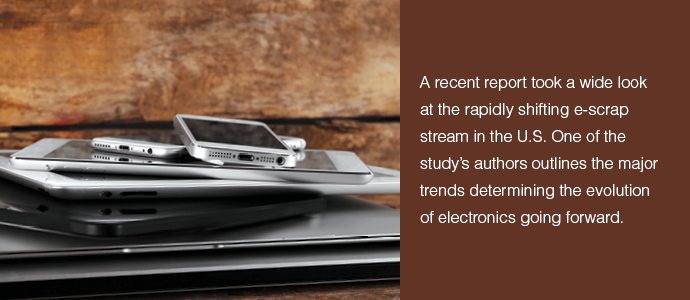News from E-Scrap
By Carole Mars on September 19, 2017
[av_hr class=’invisible’ height=’15’ shadow=’no-shadow’ position=’center’ custom_border=’av-border-thin’ custom_width=’50px’ custom_border_color=” custom_margin_top=’30px’ custom_margin_bottom=’30px’ icon_select=’yes’ custom_icon_color=” icon=’ue808′ font=’entypo-fontello’ av_uid=’av-1gnzc9g’]

[av_hr class=’invisible’ height=’10’ shadow=’no-shadow’ position=’center’ custom_border=’av-border-thin’ custom_width=’50px’ custom_border_color=” custom_margin_top=’30px’ custom_margin_bottom=’30px’ icon_select=’yes’ custom_icon_color=” icon=’ue808′ font=’entypo-fontello’ av_uid=’av-13mtrkk’]
As a researcher at an organization called The Sustainability Consortium, I was part of the group that last year published the “Electronics Recycling Landscape” report. The study, funded by the Closed Loop Foundation, looked at major trends in the electronics industry as well as flows and potential volumes of used electronics in the U.S.
The research also assessed the attitudes and views of those participating in the country’s system for used electronics management.
This article follows up on that second part of the investigation, laying out some of the key talking points and emerging ideas in electronics recovery picked up through informal conversations with colleagues and stakeholders. This analysis is by no means a comprehensive list of all the issues in front of the industry today. Rather, the aim is to offer up a range of key topics to watch over the next year.
Small critiques of research
It may be helpful to start by looking back at the response to the report itself in 2016. We found it to be well received, with only two areas in which some stakeholders identified notable omissions. First, it was noted we did not credit the state e-scrap programs for their material recovery accomplishments. That was a fair point – legislated state programs now in place in more than 20 states have been successful in diverting a significant amount of electronics into recovery systems, and they are playing an important role in the larger dialogue about how we will think about and measure used electronics collection.
The second criticism we heard was that we did not mention or cover the question of obsolescence, especially as related to software support for older hardware. This is an important topic directly influencing the generation of used electronic equipment and deserves a full consideration of the issues and influences affecting product obsolescence, so will not be considered here.
Nonetheless, the report did dig into some critical territory. Some of the big trends identified – electronics becoming smaller, lighter and more integrated; weight becoming an ineffective measure of program effectiveness; and the declining amounts of precious metals and other valuable materials in used devices – have continued on their respective trajectories.
In interviews last year, the overriding feeling across all stakeholders was a deep pessimism regarding the future of responsible used electronics management. Unfortunately, this has not abated and in fact is now accompanied by heightened uncertainty and, in some cases, frustration.
Certainly, some of the concerns we heard about working to shift management systems to the realities of a changing electronics stream were influenced by the fact that commodity prices fell in recent years. Prices have recovered some over the past 12 months, but they are still nowhere near the levels seen at the time many state programs were first put in place.
However, the frustration among some stakeholders runs deeper than just reactions to what’s been seen in markets. Disappointingly, conversations around design and management of small appliances, such as coffee makers and vacuum cleaners, have not started, and very little progress has been seen toward creating a more robust, responsible system.
But while pessimism does still permeate this space, there are reasons to be hopeful regarding developments and innovations to further responsible management.
[av_hr class=’invisible’ height=’50’ shadow=’no-shadow’ position=’center’ custom_border=’av-border-thin’ custom_width=’50px’ custom_border_color=” custom_margin_top=’30px’ custom_margin_bottom=’30px’ icon_select=’yes’ custom_icon_color=” icon=’ue808′ font=’entypo-fontello’ av_uid=’av-s3dhn8′]
